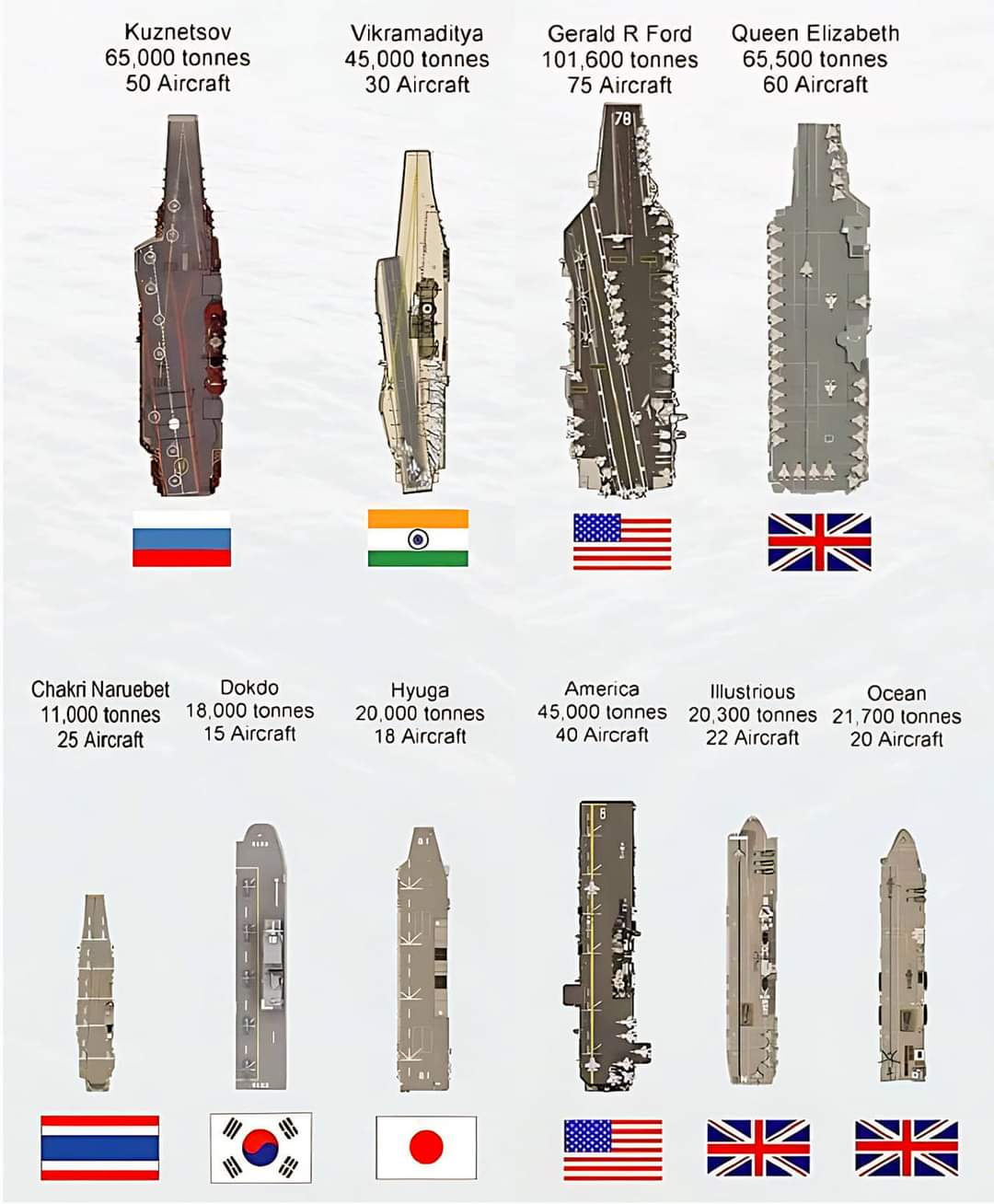
Pic Courtesy Net
My article published in the News Analytics Journal (Dec 24)
Maritime aviation refers to using military aircraft by naval forces to extend their reach and effectiveness in maritime operations. It encompasses various roles and responsibilities, including reconnaissance, air defence, anti-submarine warfare, strike missions, and search & rescue. Naval aviation is crucial in maintaining a nation’s maritime security and projecting power over the seas. Aircraft Carriers are large warships equipped with a flight deck for on-board aircraft. They are mobile airbases, allowing navies to project air power far from their home bases. The carrier-based aircraft are specially designed to operate from the deck of an aircraft carrier. They include fighters, bombers, early warning aircraft, and helicopters.
Employment of Carrier-Based Airpower. Carrier-based airpower has been pivotal for nations to project strength, maintain regional stability, and respond to crises worldwide. With their unique mobility, flexibility, and force projection capabilities, aircraft carriers allow them to exert influence across vast oceans and landmasses, often far from their borders. Carrier-based airpower enables nations to demonstrate strength and exert control in distant regions without relying on foreign bases. Carrier-based airpower serves as a powerful deterrent. The mere presence of an aircraft carrier near a crisis area signals a readiness to escalate, which can compel adversaries to negotiate or de-escalate tensions. By deploying carriers to allied nations or engaging in joint naval exercises, Maritime powers reassure allies of their commitment to regional stability.
Distinctive Features of Carrier-Based Fighter Aircraft. Carrier-based fighter aircraft have unique design features and operational capabilities that enable them to operate from aircraft carriers’ limited space and moving platforms. These fighter aircraft are typically equipped with catapult hooks for rapid acceleration on take-off, allowing them to reach flying speed in a short runway distance. Some also have vertical or short take-off capabilities, like the F-35B’s STOVL (Short Take-Off and Vertical Landing) technology, enabling them to launch from carriers without catapult systems. Landing on a moving carrier requires extreme precision. Carrier fighters are equipped with a tail hook that catches on arrestor cables on the deck, allowing them to decelerate from high speeds to a complete stop in a very short distance. Carrier landings are much harder than land-based landings. Carrier-based fighters have rugged, reinforced landing gear and overall structural durability to withstand these impacts. Carrier space is at a premium, so many carrier-based fighters, like the F/A-18 Hornet, have foldable wings. This design allows more aircraft to be stored and manoeuvred on the carrier deck and hangar spaces, optimising space usage. Operating at sea, especially in saltwater environments, can lead to high corrosion levels. Carrier fighters are designed with corrosion-resistant materials and coatings to withstand harsh, moist, and salty conditions.
Carrier-Based Airpower Capability of the Indian Navy
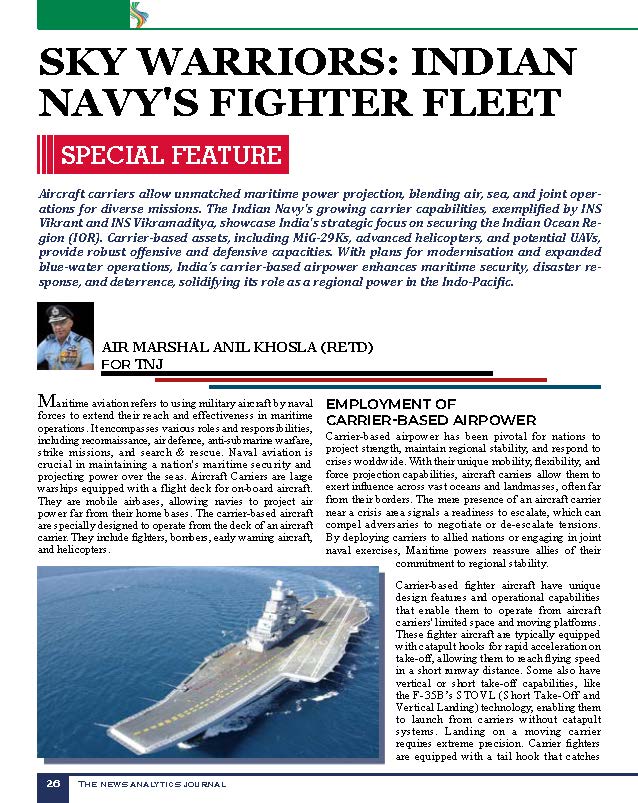
The Indian Navy’s carrier-based airpower is critical to its maritime strength and regional influence. Focusing on enhancing blue-water capabilities and ensuring security in the Indian Ocean Region (IOR), the Indian Navy’s aircraft carriers and aircraft enable India to project power, conduct rapid-response missions, and engage in multilateral operations.
INS Vikramaditya and INS Vikrant. INS Vikramaditya is India’s flagship carrier. It is a modified Kiev-class carrier acquired from Russia and commissioned in 2013. It is a STOVL (Short Take-Off but Arrested Recovery) platform, primarily operating MiG-29K fighters. INS Vikrant (IAC-1), India’s first indigenously designed and built aircraft carrier, was commissioned in 2022. It’s also a STOVL carrier and can operate a similar air wing as Vikramaditya, enhancing operational flexibility and redundancy. The aircraft carriers are equipped to operate in the Indian Ocean and project power into nearby strategic areas, especially along vital maritime chokepoints like the Strait of Malacca.
MiG-29K Fighter Jets. The MiG-29K is the Indian Navy’s primary carrier-based fighter. It is capable of both air-to-air and air-to-ground roles. It is a multirole fighter with advanced avionics, sensors, and a range of air-to-air and air-to-surface missiles. The MiG-29Ks offer versatility for various missions, including interception, strike, reconnaissance, and anti-ship warfare. They are well-suited for the maritime environment and equipped with radar and infrared tracking for air combat. The Indian Navy is considering the Rafale M, the carrier-based version of the Rafale, to supplement or replace the MiG-29K soon. The Rafale M is a multirole fighter with air superiority, deep strike, and maritime strike capabilities. It would add significant combat capability to the fleet if procured.
Rotary-Wing Capabilities. Indian Navy carriers and other ships also host a variety of helicopters that support a range of missions, from anti-submarine warfare (ASW) and search and rescue (SAR) to logistics and airborne early warning (AEW). Kamov Ka-31 helicopters are equipped for airborne early warning, providing surveillance and monitoring against aerial threats and helping to enhance the carrier group’s situational awareness. MH-60R Seahawk helicopters, recently acquired from the U.S., bring advanced ASW capabilities. These are equipped with sophisticated sensors, sonobuoys, and torpedoes to counter submarine threats, a critical role given the growing presence of submarines in the Indian Ocean.
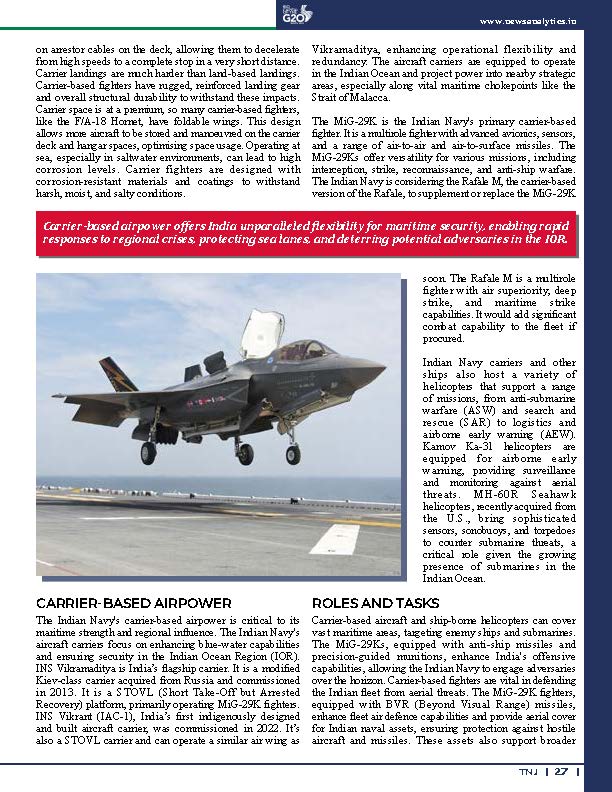
Roles and Tasks. Carrier-based airpower allows the Indian Navy to control access to the Indian Ocean and deter hostile forces. Carrier-based aircraft and ship-borne helicopters can cover vast maritime areas, targeting enemy ships and submarines. The MiG-29Ks, equipped with anti-ship missiles and precision-guided munitions, enhance India’s offensive capabilities, allowing the Indian Navy to engage adversaries over the horizon. Carrier-based airpower allows for sustained surveillance over the Indian Ocean, a vast area monitored to counter piracy, terrorism, and unauthorised military activities. Carrier-based fighters are vital in defending the Indian fleet from aerial threats. The MiG-29K fighters, equipped with BVR (Beyond Visual Range) missiles, enhance fleet air defence capabilities and provide aerial cover for Indian naval assets, ensuring protection against hostile aircraft and missiles. These assets also support broader naval operations, including protecting shipping lanes, conducting interdictions, and supporting amphibious operations. Indian carriers have proven useful in disaster response and humanitarian missions. Their helicopters can quickly reach affected areas, delivering supplies, medical assistance, and evacuation support. This capability strengthens India’s ability to provide aid in the IOR, reinforcing regional influence and goodwill, which aligns with India’s role as a “net security provider” in the region. The Indian Navy participates in exercises like Malabar with the U.S., Japan, and Australia, using its carriers to enhance interoperability with friendly navies. This strengthens India’s operational experience and integration with regional powers, reinforcing maritime security in the Indo-Pacific. These exercises also demonstrate India’s carrier capabilities and readiness, sending a strategic message to potential adversaries in the region.
Harnessing Ship-borne Airpower as A Game-Changing Force Multiplier in Future
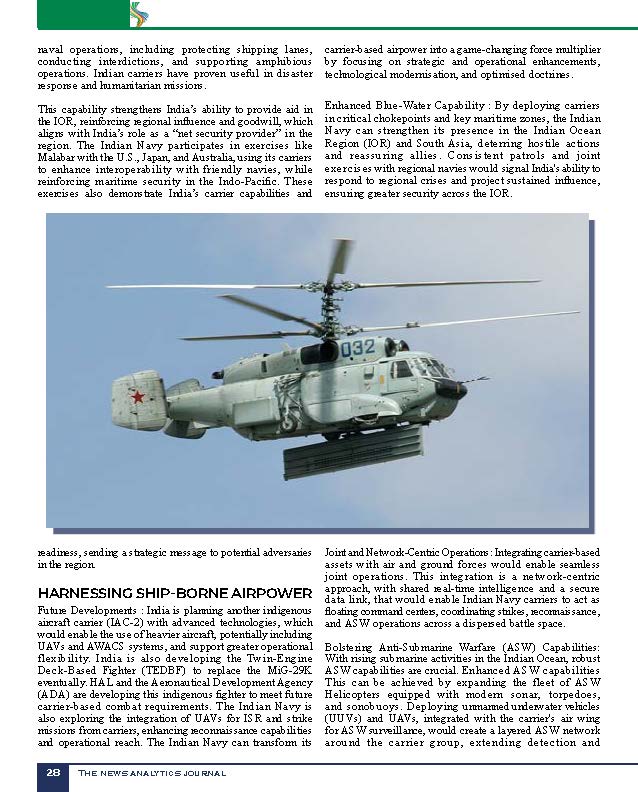
Future Developments in Indian Carrier-Based Airpower. India is planning another indigenous aircraft carrier (IAC-2) with advanced technologies, which would enable the use of heavier aircraft, potentially including UAVs and AWACS systems, and support greater operational flexibility. India is also developing the Twin-Engine Deck-Based Fighter (TEDBF) to replace the MiG-29K eventually. HAL and the Aeronautical Development Agency (ADA) are developing this indigenous fighter to meet future carrier-based combat requirements. The Indian Navy is also exploring the integration of UAVs for ISR and strike missions from carriers, enhancing reconnaissance capabilities and operational reach. The Indian Navy can transform its carrier-based airpower into a game-changing force multiplier by focusing on strategic and operational enhancements, technological modernisation, and optimised doctrines.
Enhanced Blue-Water Capability and Persistent Maritime Presence. By deploying carriers in critical chokepoints and key maritime zones, the Indian Navy can strengthen its presence in the Indian Ocean Region (IOR) and South Asia, deterring hostile actions and reassuring allies. Consistent patrols and joint exercises with regional navies would signal India’s ability to respond to regional crises and project sustained influence, ensuring greater security across the IOR.
Force Multiplication through Joint and Network-Centric Operations. Integrating carrier-based assets with air and ground forces would enable seamless joint operations. This integration would allow carrier-based fighters to coordinate with land-based assets in maritime interdiction and rapid strike missions. A network-centric approach, with shared real-time intelligence and a secure data link, would enable Indian Navy carriers to act as floating command centers, coordinating strikes, reconnaissance, and ASW operations across a dispersed battle space.
Bolstering Anti-Submarine Warfare (ASW) Capabilities. With rising submarine activities in the Indian Ocean, robust ASW capabilities are crucial. Enhanced ASW capabilities can be achieved by expanding the fleet of ASW Helicopters equipped with modern sonar, torpedoes, and sonobuoys. Deploying unmanned underwater vehicles (UUVs) and UAVs, integrated with the carrier’s air wing for ASW surveillance, would create a layered ASW network around the carrier group, extending detection and engagement capabilities against adversarial submarines.
Integrating Long-Range Strike Capabilities. Equipping carrier-based aircraft with advanced long-range anti-ship and land-attack missiles, such as the BrahMos-NG and future Indigenous missiles, would enable carriers to strike targets over 500 kilometres away, beyond the line of sight. Long-range strike capabilities also make the carriers a credible threat to adversarial naval and ground installations, enhancing India’s maritime deterrence and extending its strategic reach in the Indo-Pacific region.
Utilising Unmanned Aerial Vehicles (UAVs) for Persistent ISR and EW. UAVs like the Predator MQ-9B (currently operated by the Navy) and future indigenous models could be launched from carriers for ISR (Intelligence, Surveillance, and Reconnaissance) missions. This would extend the carrier’s situational awareness by providing real-time surveillance across a larger area. UAVs equipped for electronic warfare (EW) would enable the Indian Navy to detect, jam, and disrupt enemy communication and radar systems, reducing adversary effectiveness in a contested environment.
Strategic Partnerships and Bilateral Naval Exercises. Regular joint exercises with allies, such as the Malabar exercises with the U.S., Japan, and Australia, would enable Indian carrier strike groups to practice complex multinational operations. This fosters interoperability and sends a powerful message about India’s commitment to collective security in the Indo-Pacific. Strategic partnerships also bring technology-sharing opportunities, enabling the Indian Navy to adopt best practices in carrier operations and leverage allies’ EW, ISR, and ASW technologies.
Expanding Multi-Carrier Capabilities. With the addition of the INS Vikrant and potential future carriers, the Indian Navy could deploy multiple carrier groups to different strategic areas or concentrate them in one for a more powerful deterrent. Multi-carrier capabilities enable excellent force projection and strategic flexibility, allowing the Navy to respond to simultaneous challenges across the IOR and enhance its role as a regional security provider.
Strengthening Doctrine and Tactical Flexibility. Developing an adaptive maritime doctrine for carrier-based operations focused on the Indian Ocean’s unique geostrategic demands will allow the Navy to respond to evolving threats rapidly. Adopting a mix of offensive and defensive tactics would help balance the roles of power projection and area denial.
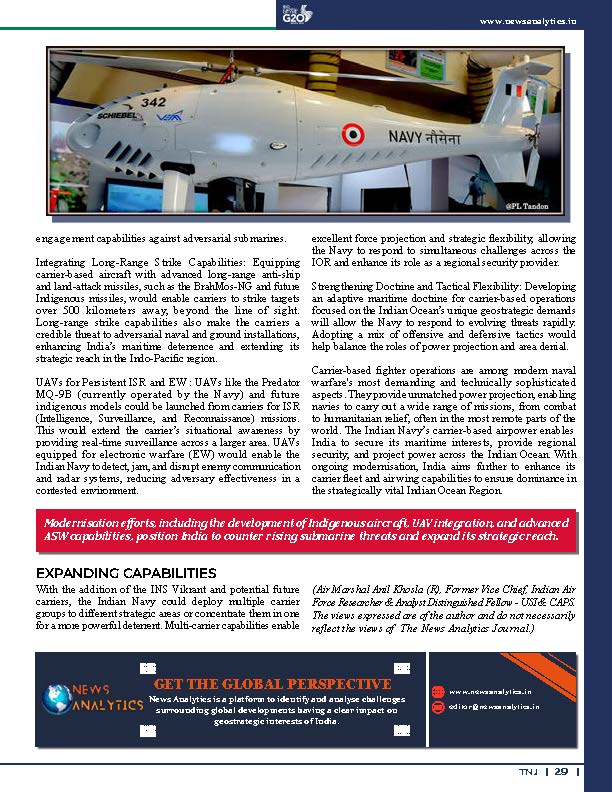
Carrier-based fighter operations are among modern naval warfare’s most demanding and technically sophisticated aspects. They provide unmatched power projection, enabling navies to carry out a wide range of missions, from combat to humanitarian relief, often in the most remote parts of the world. The Indian Navy’s carrier-based airpower enables India to secure its maritime interests, provide regional security, and project power across the Indian Ocean. With ongoing modernisation, India aims further to enhance its carrier fleet and air wing capabilities to ensure dominance in the strategically vital Indian Ocean Region.
Link to the article on the website:
Your valuable comments are most welcome.
For regular updates, please register your email here:-
References and credits
To all the online sites and channels.
Disclaimer:
Information and data included in the blog are for educational & non-commercial purposes only and have been carefully adapted, excerpted, or edited from reliable and accurate sources. All copyrighted material belongs to respective owners and is provided only for wider dissemination.
